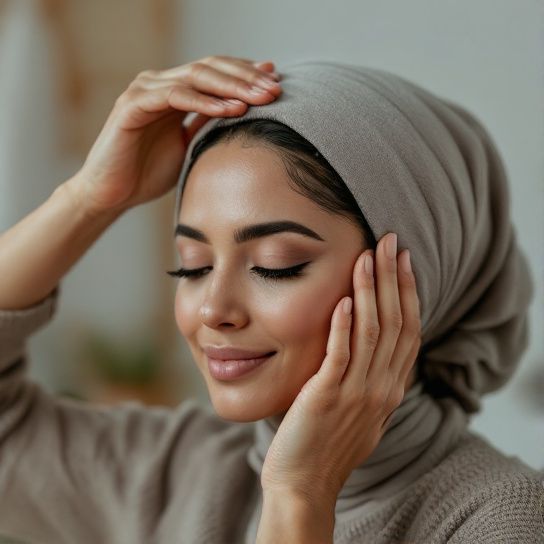Hijab Hair Diary: Document Your Journey to Healthier Hair

Care Techniques for Hijabi Hair and Scalp Health
Embracing the hijab is both a spiritual choice and a lifestyle commitment, and it necessitates a dedicated approach to hair and scalp care. Covering your hair for extended periods can lead to various challenges such as scalp irritation, dryness, weakened hair tracks (commonly known as the “root” or “base” of the hair), and an overall increase in hair fragility. There are, however, several evidence-based strategies one can adopt to maintain hair integrity and scalp health.
Understanding Hair and Scalp Challenges for Hijabis
- Moisture Retention: Hair covered for long durations tends to lose moisture, leading to dry and brittle tracks. This is especially true in dry or overly humid climates where the scalp can have imbalanced moisture.
- Scalp Breathability: A barrier continuous head covering can hamper airflow to the scalp, resulting in excess sweat and, potentially, scalp irritation or fungal issues.
- Track Health: The hair’s base or tracks need special attention to prevent weakness or hair fall, especially due to prolonged pressure or friction from hijab styles.
Evidence-Based Care Practices

- Cleansing and Conditioning: Use a gentle, sulfate-free, and paraben-free shampoo to cleanse your hair without stripping its natural oils. Add a moisturizing conditioner focused on strengthening tracks and enhancing scalp moisture. For example, the **SheaMoisture Jamaican Black Castor Oil Shampoo and Conditioner set is renowned for its fortifying properties that promote scalp health and strengthen hair roots.
- Scalp Massage: Regularly massage your scalp to encourage blood flow and nutrient delivery to the roots. This practice, carried out 2-3 times a week with a nourishing oil like argan oil or jojoba oil, can improve track health.
- Leave-in Treatments: Incorporate a leave-in conditioner or a hydrating mist. The **Cantu Leave-In Conditioning Repair Cream provides hydration and strengthens hair, protecting against the friction from daily or tight hijab styles.
- Protective Styles and Materials: Use silk or satin underscarves to reduce friction and help retain hair moisture. These materials are gentler on tracks and reduce breakage compared to rough fabrics like cotton. Opt for looser styles that alleviate tension from the hair roots.
- 5. **Hydration and Nutrition: Internal hydration plays a significant role in hair health. Ensure you drink ample water and maintain a balanced diet rich in Omega-3 fatty acids, vitamins (like B, C, E, and D), and minerals (such as zinc and iron) that support strong and healthy hair tracks.
- 6. **Regular Trimming: Keep hair ends trimmed every 6 – 8 weeks to prevent and manage split ends that can travel up the track, weakening hair further.
Preventive Measures for Common Issues


- Dandruff and Itchiness: Often caused by lack of ventilation, ensure you wash your hajabs regularly and consider using an anti-dandruff shampoo once a week, such as the **Head & Shoulders Clinical Strength Shampoo, which is effective yet gentle on the hair.
- Hair Thinning: Introduce biotin-rich supplements, with professional consultation, to aid in hair density, ensuring supplementation complements your diet and doesn’t interfere with any other health needs.
By prioritizing these targeted, culturally-inclusive practices, hijabi women can maintain not only the aesthetic beauty of their hair but also its health and integrity. These solutions serve both a testament to respecting religious traditions and attentiveness to personal well-being.
Frequently Asked Questions
How can I prevent hair loss and breakage while wearing a hijab?
To prevent hair loss and breakage, it is crucial to use gentle hair care practices. This includes using soft scarf materials, avoiding friction by changing your hair parting regularly, and ensuring your hair is in a protective style. Additionally, moisturizing both the scalp and hair strands is essential[1][4][5).
What are the signs of hair loss in women who wear hijab?
Signs of hair loss include increased hair shedding, thinning hair, especially around the crown or along the parting, and a widening part. Monitoring the amount of hair in your hairbrush, on your pillow, or in the shower drain can help identify these issues early[5).
How often should I pamper my hair while wearing a hijab?
It is recommended to pamper your hair at least once a week or every two weeks. This can include thorough showers, post-shower regimens, and using hydrating products to keep your hair strong, shiny, and full of moisture[4).
What are some effective haircare tips for hijabis to maintain healthy hair?
Effective tips include periodically massaging your scalp with natural oils like coconut, olive, or argan oil to stimulate blood flow to the hair follicles. Also, using gentle hair care products and maintaining a thorough shower and post-shower regimen are crucial. Avoiding friction and ensuring good ventilation under the hijab is also important[2][4][5).
References






